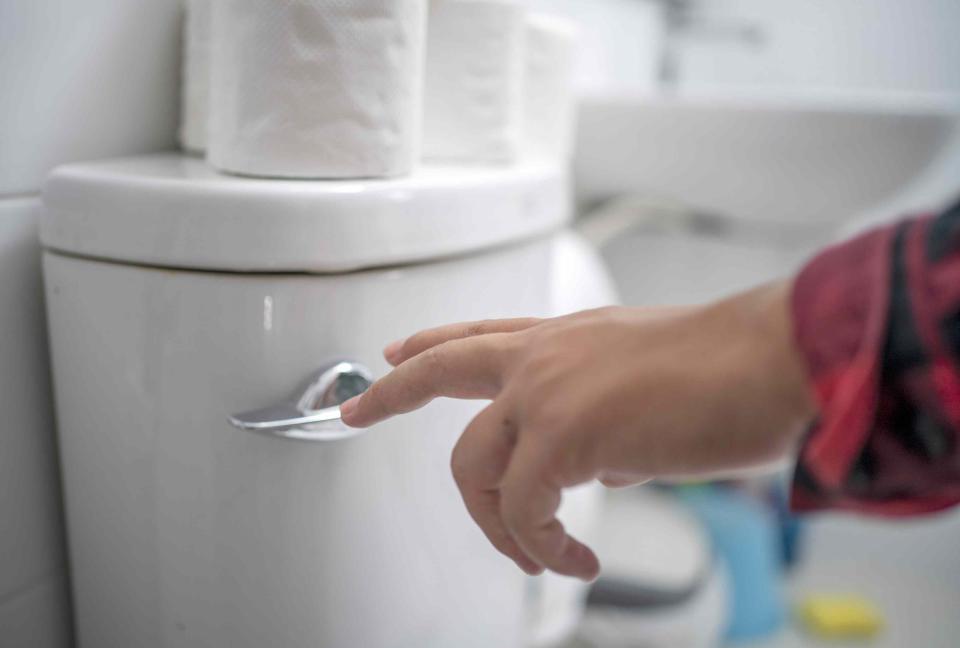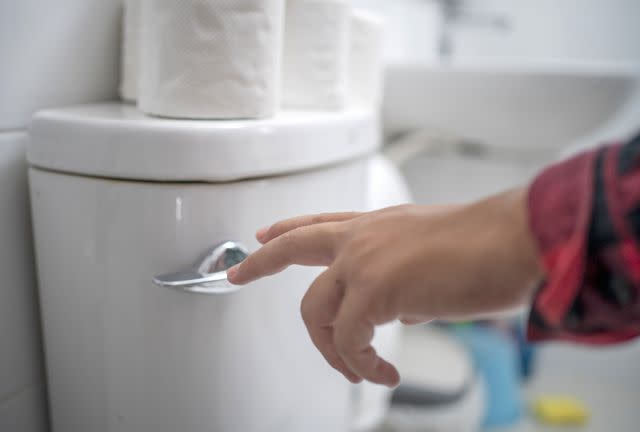Does Appendicitis Change Poop Color?
It can, but is not the most likely cause

Boonchai Wedmakawand / Getty Images
Medically reviewed by Sonal Kumar
Appendicitis can cause poop color changes, but this is not a common sign. There have been rare reports of appendicitis causing red/reddish-black stool. Since an inflamed appendix is often associated with hardened stool, dark brown to black poop is more likely.
Still, poop color changes are not telltales of the condition. More reliable symptoms and signs of appendicitis include severe and worsening abdominal pain, fever, and vomiting blood. These should prompt you to seek immediate medical attention, regardless of the color of your stools.
This article discusses how appendicitis might affect poop color, other possible—and more likely—causes of these changes, additional signs of appendicitis, and how a healthcare practitioner can confirm your diagnosis.

Boonchai Wedmakawand / Getty Images
How Appendicitis May Change Poop Color
Constipation can be a symptom of appendicitis. This tends to occur after the pain sets in. The hardened stools you eventually pass could appear much darker than usual. This is not because they contain blood—a possible reason for dark stools—because they are dehydrated and concentrated.
There have been a few older case reports of dark or black poop occurring as a symptom of appendicitis itself, but these are uncommon. And when this does occur, it is more likely because appendicitis occurs alongside another condition, such as bleeding in the GI tract or appendiceal endometriosis (when tissue similar to the lining of the uterus grows on the appendix).
Dark stools are not a typical symptom of appendicitis and should not be used as a way of distinguishing it from another condition.
Other Causes of Poop Color Changes
Dark/black stool can be caused by something you ate, like black licorice, or a medicine such as Pepto-Bismol (bismuth subsalicylate).
It can also be caused by other kinds of serious problems that are more often associated with this sign than appendicitis.
Some of these other conditions include:
Gastritis, an inflammation of the stomach
A tear in the esophagus
Diseases of the colon
Related:The Meaning of Poop Colors, Shapes, Sizes, and Consistency
Other Symptoms of Appendicitis
Paying attention to these signs of appendicitis, rather than your stool color, is much more important in helping you identify a possible inflamed appendix early so you can get the urgent treatment you need:
Sudden, severe abdominal pain that starts around the belly button, progresses, and moves to the lower right part of your abdomen
Abdominal pain that worsens with movement or coughing
Loss of appetite
Nausea and vomiting
Vomiting blood
Low-grade fever
Chills
Lightheadedness
Irregular heartbeat
Waiting to get treatment for appendicitis increases the chances that your appendix will rupture.
The late signs of appendicitis appear only after rupture has occurred. At first, you may feel better because you no longer have pressure in your appendix. However, bacteria begins to spread throughout your abdominal cavity, which can cause a dangerous condition called peritonitis.
Symptoms of peritonitis include:
Severe, constant pain throughout your abdomen
High fever
Chills
Weakness
Increased heart rate
Confusion
Related:9 Signs That Your Stomach Issues May Not Be IBS
Summary
Red, red-black, dark brown, and black poop color changes could occur with appendicitis, but abdominal pain, fever, vomiting blood, and other symptoms are far more common. Possible appendicitis requires immediate medical attention.
Stool color changes are more likely to be related to bleeding in the gastrointestinal tract, such as from a peptic ulcer.
Blood in stool or dark poop color should be evaluated by a healthcare provider. Seek immediate medical care if you also experience fever, severe abdominal pain, dizziness, confusion, rapid heart rate, and other concerning symptoms.
Related:Does Appendicitis Always Require Surgery?
Frequently Asked Questions
Can IBS be confused with appendicitis?
Yes. In fact, research shows people with IBS are twice as likely to have an unnecessary appendectomy based on symptoms.
Can you poop when you have appendicitis?
Possibly, but maybe not. One of the symptoms of appendicitis is constipation, though diarrhea is also possible. Being able to poop does not rule out appendicitis.
Do I have trapped gas or appendicitis?
Trapped gas and appendicitis can have similar symptoms. Typically, appendicitis pain either travels from the navel to the right lower quadrant of the abdomen or is only felt in the lower right abdomen. Gas pain can also migrate, however, it tends to be felt in different parts of the abdomen.
What does appendicitis feel like at the beginning?
Sudden pain in the lower right quadrant of the abdomen is usually the first sign of appendicitis. The pain may also begin near the navel and travel to the lower right side. The pain often worsens if you cough, walk, or make other quick movements. Other symptoms of appendicitis include nausea, vomiting, loss of appetite, low-grade fever, constipation, diarrhea, abdominal bloating, and gas.
How long can you have appendicitis symptoms before it bursts?
An infected appendix can rupture in as little as 48 to 72 hours. If you experience symptoms of appendicitis, seek immediate medical treatment.

